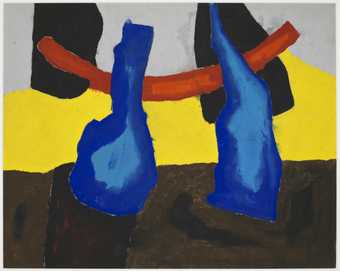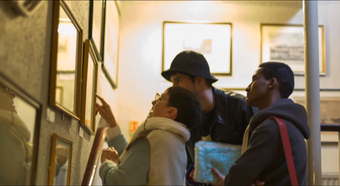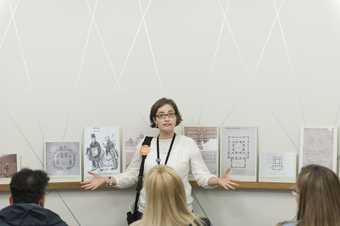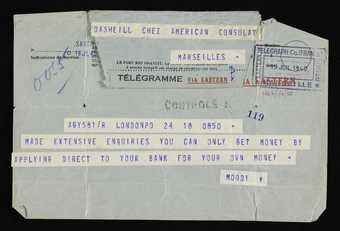
Aubrey Williams
Abstract painting
([1970s])
Tate Archive
Opening up the archive
The Archives & Access project enabled Tate Archive to digitise thousands of letters, sketches and diary pages created by artists. While this meant that these materials were now available to view online, this did not automatically guarantee that they would be actively or creatively used. To find out how people might want to interact with the archives and to invite new interpretations and uses of the materials, two participatory programmes were developed.
The Learning Outreach programme was a collaboration between Tate and five cultural organisations to explore the archives with schools and community groups across the UK. The Volunteering programme at Tate Britain engaged a diverse range of participants in taking care of the archive and sharing it with gallery visitors.
Learning and Outreach
The learning outreach activities we developed with our partners were shaped by the locations where they took place and the needs and interests of the groups taking part. They drew on a diverse range of archive material, including the artists’ archives in the Tate Archive (both online and in some cases on-site at Tate Britain) and local and national archives and heritage sites, including the People’s Collection Wales, the Liverpool Medical Institution, Canterbury Cathedral, the South-East Archive of Seaside Photography and Kensal Green Cemetery.
The partners commissioned artists to work with the project participants and they brought a wide variety of arts practices to the activities. As well as supporting participants to develop creative skills, the artists introduced experimental approaches to searching and navigating the archive collections. They also encouraged participants to try out and reflect on different approaches to creative working. Drawing on their own practices and on the archive’s sketchbooks, maquettes and scribbled notes the artists provided an insight into how people work and think and the false starts and new discoveries that they make along the way.
The activities supported participants to develop their own understanding of the archive, find items and themes that were relevant to them in the collections and make their own creative responses to archives.
The case studies below show some of the different types of activities that were used, to illustrate the range of potential approaches to learning with archives.
Case study 1: The Archive Box
For the All About Us project with Alder Hey Children’s Hospital artist Harriet Hall and trainee Michaela Swan needed to be able to work flexibly with the young patients wherever they might be: whether they were in bed, in a waiting area or in the classroom of the hospital school. Also internet access to view the archive online was not guaranteed in all of the hospital departments. So, Harriet and Michaela created an ‘archive box’ of physical objects for participants to handle, look at and respond to.
They looked at images and objects relating to the hospital’s history gathered as part of recent centenary celebrations, alongside our archive and the Liverpool Medical Institution archives. The resulting collection included a stethoscope, an old nurse’s badge, a leg splint designed by a doctor from Liverpool, a World War I service medal, photographs of Alder Hey and printed images of materials from the archive.
The archive box was used as a starting point for sensory play and discussions with groups and individuals and it was photographed and sketched as part of creative activities. At the final exhibition, the archive box and its contents were displayed alongside all of the participants’ work.
Case study 2: Vocalising the Archive
As part of Mining Josef Herman, the Josef Herman Art Foundation Cymru commissioned artist Rabab Ghazoul to respond to sketches by Polish émigré artist Josef Herman held in the archive, many of which show the town of Ystradgynlais where Herman lived from 1944-1955.
Rabab undertook nine months of research with people living in and around Ystradgynlais before developing a final performance piece. During her research workshops, she introduced project participants to the sketches online and used them as the starting point for discussions which ranged from informal conversations to in-depth, recorded interviews. These discussions took in a wide range of topics including Herman’s time in Ystradgynlais, the changes to the town and the local mining industry since the 1940s, Herman’s artistic techniques, and contemporary politics. Rabab also worked with people to make connections between the sketches and selected passages from Herman’s writings and to create their own written responses or poems.
Building on this research she collaborated with two local choirs, one a well-established male voice choir and the other a school choir. They held a public rehearsal of music based on Herman’s sketches and writings. The public were invited to drop in for a few minutes or for the whole duration of the event which closed with an informal final performance of sung and spoken word pieces presented against a backdrop of projections of Herman’s sketches.
Rabab’s creative research is documented through a series of three Albums on Tate's website.
Case study 3: Archives and the Everyday
Art Assassins, the young people’s group at South London Gallery, worked with the artist Hannah Lees for their self-led project as part of Stories Uncovered. Taking inspiration from the concept of collecting and the everyday, ephemeral nature of some of the materials found in the archive, the group looked at ways of archiving daily life.
Their activities were wide-ranging. They went mudlarking on the banks of the River Thames and curated a collection from the discarded objects which they gathered. They then went on to discuss digital collecting and created a new hashtag #allinsouthlondon on Instagram to try to collate and archive their experiences of life in their local area. Members of the group also undertook individual creative projects to contribute to the collection of material from making field recordings to 3D imaging.
The hashtag #allinsouthlondon is still being used by the group to collect all the images they create and thereby make an ongoing archive of the Art Assassins’ work.
Case study 4: Drawing from the Archives
When young people taking part in the learning outreach programme visited Tate Archive one of the group started sketching the materials that he was looking at and the others quickly did the same. It is rare for researchers in the Reading Rooms to use drawing as a way of working with the archive materials and this experience inspired the Library and Archive and Archives & Access teams to work together on an experiment. They designed two drawing workshops based on the artists’ sketchbooks which had been digitised as part of Archives & Access.
Staff selected material from the archive which showcased the diverse range of artists represented in the collection as well as a variety of drawing and research techniques. They then devised a number of simple activities that could be done with minimal resources (sketchbooks, graphite pencils, red pencils, stencils and gridded paper) and could be achieved in a short timeframe but also had flexibility for extension and development. The workshops were run as a structured workshop for a school group with the young people taking 10-15 minutes to try each activity in turn and as a public drop-in workshop which was open for participants to spend as much or as little time as they wished on an activity. As the sketchbooks had been digitised, workshop participants would be able to do further research after the workshops at home or in the classroom.
A learning resource was also produced using Albums to encourage more people to learn with and sketch from the online archive material.
Case study 5: Taking the Archive to the Audience
Pupils from Laleham Gap School had a range of speech, language and communication needs which meant that it would be challenging for the group to visit an archive or heritage site as other participating groups in the On Margate Sands project had done. Instead we worked with staff from Turner Contemporary and the school worked to bring the archive to the gallery in Margate for a day, a venue that was already familiar to the young people.
The Library and Archive teams developed and devised a tailored workshop for the group. They created an image-based presentation about the archive and the different roles in the team, as well as short videos of staff working in the offices, stores and reading rooms to give a sense of the space. A selection of facsimiles and equipment that are used every day in the archive was put together to be transported to Turner Contemporary for the workshop.
On the day of the workshop these resources and props were used to give the school students a hands-on introduction to the archive. This was followed by a practical activity where the pupils learned how to organise, catalogue, store and retrieve archive items and tried out all the different steps themselves with facsimile archive materials.
Case study 6: Archives and Exchange
To bring young and older people together as part of Changing Landscapes, Changing Lives project, the team at the Laing Art Gallery devised an Art Exchange, inspired by the letters and notes in the archive.
The project trainee Fran Taylor recruited older participants by using the gallery’s existing mailing list to invite people over the age of 55 to register their interest in an exchange with young people. Fran and the project artist Nicola Maxwell then designed an instruction leaflet and selected young people’s artwork from the Changing Landscapes, Changing Lives workshops for the exchange. They then sent the instructions and an image to each of the older people who volunteered to take part. The participants were asked to make a response in any artform and return it to the gallery by mail, email or in person.
The response rate was high with 26 older people submitting an artwork. Fran then digitised all of the artworks and created an Album as an online exhibition of all the participants’ creative exchanges.
evaluation and reflection
Working with an external evaluator allowed us and our partners to reflect on and review activities and share learning across the partnership throughout the course of the programme. The evaluator produced a Final Evaluation for the programme.
The following recommendations for working with archives are drawn from the Final Evaluation.
Volunteering
The Archives & Access Volunteering programme enabled us to develop new volunteering roles at Tate which increased access to, and understanding of, the archives.
Tate has run active volunteering programmes for many years. We value volunteering as a way to broaden participation in our galleries and appreciate the enthusiasm, skills and perspectives that volunteers bring to their roles. Drawing on these experiences and to provide opportunities for direct participation with the archives, volunteering was built into the Archives & Access project from its earliest planning stages.
The programme provided increased access to the archive through two different roles Preservation Volunteers and Archive Explorer Volunteers.
Preservation Volunteers
The Preservation Volunteers help to preserve and care for Tate archives, working directly with the archive materials.
They have been trained in handling and preservation techniques and have helped to check and package all of the materials involved in the digitisation process for Archives & Access. This not only helped to support the publication of the archives for new online audiences, but also ensured that the materials could be handled safely in future by staff and researchers in the Reading Rooms.
During weekly sessions, they work as a team with the Tate archive staff to organise and re-house fragile photographs, letters and documents in special conservation folders and sleeves, while checking the condition of the materials and numbering each piece. They are also involved in unique tasks and specialised tasks such as creating bespoke boxes for artists’ sketchbooks to keep them safe for years to come.
Since I have been helping with the Tate Volunteer Team it has been so interesting to learn the special ways we must handle all the documentation, photographs and sketchbooks. Each kind of material has its own unique and specialized techniques and tools that must be used in specific ways in order to handle each item in the most sensitive and careful way possible.
- Preservation Volunteer
Archive Explorer Guides
Archive Explorer Volunteers run free public tours at Tate Britain every Saturday and Sunday. The 30-minute tours introduce gallery visitors to the archive and the Archive Gallery, opened as part of Archives & Access, and aim to make its displays as accessible as possible.
At the start of the programme the Archive Explorer volunteers were given intensive training before being supported to devise and deliver their tours. They learned about Tate, its aims, the history of the gallery and the archive’s contents, as well as developing or enhancing face-to-face people skills. The tours are reviewed on a regular basis when there is a changeover in displays in the Archive Gallery.
Excellent tour and talk - history of Tate so interesting. Great presentational style - clear accessible and inspiring. Thank you!
– Tour participant
The programme was overseen by a dedicated Volunteer Coordinator. As with all of our volunteer activities, the programme was run in line with our Diversity Strategy. To ensure the volunteering opportunities were available and accessible to diverse communities living in the area around Tate Britain, the Coordinator took a strategic approach and established contact with a large number key local agencies beyond our existing volunteer recruitment network. She met and talked with a wide range of people to tell them about the programme before recruitment began and provided support for potential volunteers to apply.
The Coordinator then worked with the group of over 40 recruited volunteers to train them in their roles and be the key contact for their introduction to Tate and the archives. Once the volunteers were established the volunteers worked with other members of staff at the gallery. The Coordinator continued to provide day-to-day support and organised further training, managed volunteer expenses, and arranged associated activities, such as away days.
Since the end of the Archives & Access project the volunteer programme has become part of Tate’s core volunteer activity. A team of 10 Preservation Volunteers are now managed by Tate’s Archive team and 18 Archive Explorer Volunteers are managed by Tate’s front of house Visitor Experience team.





